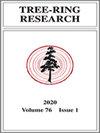Co-Occurring Wyoming Pinus Species Exhibit Differing Climate–Growth Relationships
IF 1.1
4区 农林科学
Q3 FORESTRY
引用次数: 1
Abstract
ABSTRACT The North American Dendroecological Field week (NADEF) is an intensive dendrochronology workshop, funded in part by the National Science Foundation. The 2019 Introductory Group at NADEF developed two precisely dated tree-ring width chronologies for Pinus contorta (lodgepole pine) and Pinus flexilis (limber pine) at the Wolf Knob site ca. 5 km west of Beartooth Lake, WY, within the bounds of the Shoshone National Forest (SNF), in the Greater Yellowstone Ecosystem (GYE). Wolf Knob is a semi-arid, S- to SW-facing, mid- to high-elevation site, making it an ideal location to examine the climate sensitivity of annual tree-ring width increments. Here, we show that two co-located Pinus species exhibit differing climate–growth relationships, with P. contorta exhibiting relatively weak correlations with precipitation (r = 0.37; p < 0.01) and temperature (r = –0.23; p < 0.05) during the late summer, and P. flexilis exhibiting stronger overall correlations with both cool-season (r = 0.48; p < 0.01) and warm-season precipitation (r = 0.51; p < 0.01) as well as with snowpack records (r = 0.45; p < 0.05). Our results suggest these two Pinus species may face disparate threats in the face of regional climate change, with P. flexilis being particularly vulnerable to drought conditions and declining snowpacks in the GYE. The differing seasonal climate sensitivities of the two species is likely caused by microsite conditions (e.g. soil moisture capacity, incoming solar radiation) and distinct species-climate responses, underscoring the importance of not only site selection, but also microsite and individual selection in dendroclimatological sampling. Finally, this work contributes to identifying Snow Water Equivalent (SWE)-sensitive tree-ring proxies in the GYE, critical for understanding ongoing warming-induced snowpack declines across western North America, particularly given the projections of a largely snow-free (April 1) GYE by 2075.共同发生的怀俄明州松树物种表现出不同的气候生长关系
摘要北美树木生态野外周(NADEF)是一个密集的树木年表研讨会,部分资金由美国国家科学基金会资助。NADEF的2019年介绍小组在Wolf Knob遗址为柔松(lodgepole pine)和柔性松(limber pine)开发了两个精确测年的年轮宽度年表。该遗址位于大黄石生态系统(GYE)肖松尼国家森林(SNF)范围内的怀俄明州熊齿湖以西约5公里处。Wolf Knob是一个半干旱、朝南到西南、中高海拔的地区,是研究年轮宽度增量对气候敏感性的理想地点。在这里,我们发现两个共同分布的松属物种表现出不同的气候-生长关系,其中扭曲松在夏末与降水量(r=0.37;P<0.01)和温度(r=-0.23;P<0.05)表现出相对较弱的相关性,和P.flexilis与冷季(r=0.48;P<0.01)和暖季降水量(r=0.51;P<0.01)以及积雪记录(r=0.45;P<0.05)表现出更强的整体相关性。我们的结果表明,面对区域气候变化,这两个松属物种可能面临不同的威胁,其中P.flexilis特别容易受到干旱条件和GYE积雪减少的影响。这两个物种的季节性气候敏感性不同可能是由微观站点条件(如土壤含水量、入射太阳辐射)和不同的物种气候反应引起的,这突出了在树木气候采样中不仅站点选择,而且微观站点和个体选择的重要性。最后,这项工作有助于确定GYE中对雪水当量(SWE)敏感的树木年轮指标,这对于了解北美西部持续变暖导致的积雪减少至关重要,特别是考虑到到2075年GYE将基本无雪(4月1日)的预测。
本文章由计算机程序翻译,如有差异,请以英文原文为准。
求助全文
约1分钟内获得全文
求助全文
来源期刊

Tree-Ring Research
农林科学-林学
CiteScore
2.40
自引率
12.50%
发文量
15
审稿时长
>36 weeks
期刊介绍:
Tree-Ring Research (TRR) is devoted to papers dealing with the growth rings of trees and the applications of tree-ring research in a wide variety of fields, including but not limited to archaeology, geology, ecology, hydrology, climatology, forestry, and botany. Papers involving research results, new techniques of data acquisition or analysis, and regional or subject-oriented reviews or syntheses are considered for publication.
Scientific papers usually fall into two main categories. Articles should not exceed 5000 words, or approximately 20 double-spaced typewritten pages, including tables, references, and an abstract of 200 words or fewer. All manuscripts submitted as Articles are reviewed by at least two referees. Research Reports, which are usually reviewed by at least one outside referee, should not exceed 1500 words or include more than two figures. Research Reports address technical developments, describe well-documented but preliminary research results, or present findings for which the Article format is not appropriate. Book or monograph Reviews of 500 words or less are also considered. Other categories of papers are occasionally published. All papers are published only in English. Abstracts of the Articles or Reports may be printed in other languages if supplied by the author(s) with English translations.
 求助内容:
求助内容: 应助结果提醒方式:
应助结果提醒方式:


